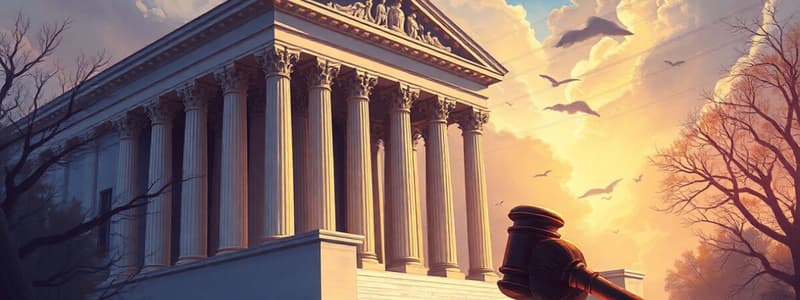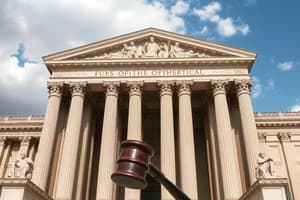Podcast
Questions and Answers
What fundamental principle was established in Marbury v. Madison (1803), and how did it alter the balance of power within the U.S. government?
What fundamental principle was established in Marbury v. Madison (1803), and how did it alter the balance of power within the U.S. government?
Judicial review; it allowed the Supreme Court to interpret the Constitution and determine the constitutionality of laws.
Explain how the Necessary and Proper Clause was interpreted in the McCulloch v. Maryland (1819) decision, and what implications this had for the scope of congressional power.
Explain how the Necessary and Proper Clause was interpreted in the McCulloch v. Maryland (1819) decision, and what implications this had for the scope of congressional power.
The Court broadly interpreted the Necessary and Proper Clause, allowing Congress to enact laws that are not explicitly listed in the Constitution as long as they are 'necessary and proper' for carrying out its enumerated powers. This expanded the power of Congress.
In Gibbons v. Ogden (1824), what definition of 'commerce' did the Supreme Court adopt, and why was this significant for federal regulation of economic activity?
In Gibbons v. Ogden (1824), what definition of 'commerce' did the Supreme Court adopt, and why was this significant for federal regulation of economic activity?
The Court defined 'commerce' broadly to include navigation, meaning that Congress could regulate interstate commerce beyond just the buying and selling of goods. This paved the way for federal regulation of various aspects of economic activity.
How did the Supreme Court's ruling in Priggs v. Pennsylvania (1842) address the conflict between state laws and federal authority regarding slavery?
How did the Supreme Court's ruling in Priggs v. Pennsylvania (1842) address the conflict between state laws and federal authority regarding slavery?
Explain the Supreme Court's reasoning in United States v. Dewitt (1869) for why Congress could not regulate internal trade within a state.
Explain the Supreme Court's reasoning in United States v. Dewitt (1869) for why Congress could not regulate internal trade within a state.
What was the central issue in Hepburn v. Griswold (1869) concerning the Legal Tender Act, and how did the Supreme Court rule on this issue?
What was the central issue in Hepburn v. Griswold (1869) concerning the Legal Tender Act, and how did the Supreme Court rule on this issue?
In Knox v. Lee (1871), how did the Supreme Court alter its stance from Hepburn v. Griswold regarding Congress's ability to issue paper money, and what was the justification for this change?
In Knox v. Lee (1871), how did the Supreme Court alter its stance from Hepburn v. Griswold regarding Congress's ability to issue paper money, and what was the justification for this change?
What was the key question in United States v. E.C. Knight Co. (1895), and how did the Supreme Court's answer limit the scope of the Sherman Antitrust Act?
What was the key question in United States v. E.C. Knight Co. (1895), and how did the Supreme Court's answer limit the scope of the Sherman Antitrust Act?
In Champion v. Ames (1903), what power did the Supreme Court affirm for Congress concerning items deemed harmful to public welfare, and how did this relate to interstate commerce?
In Champion v. Ames (1903), what power did the Supreme Court affirm for Congress concerning items deemed harmful to public welfare, and how did this relate to interstate commerce?
What was the central issue in Hammer v. Dagenhart (1918) concerning child labor, and on what grounds did the Supreme Court find the federal law unconstitutional?
What was the central issue in Hammer v. Dagenhart (1918) concerning child labor, and on what grounds did the Supreme Court find the federal law unconstitutional?
Explain how the Supreme Court in Schechter Poultry Corp v. United States (1935) used the non-delegation doctrine and separation of powers to invalidate the National Industrial Recovery Act.
Explain how the Supreme Court in Schechter Poultry Corp v. United States (1935) used the non-delegation doctrine and separation of powers to invalidate the National Industrial Recovery Act.
How did the ruling in NLRB v. Jones & Laughlin Steel Corp. (1937) represent a shift from earlier Supreme Court decisions regarding the regulation of local activities affecting interstate commerce?
How did the ruling in NLRB v. Jones & Laughlin Steel Corp. (1937) represent a shift from earlier Supreme Court decisions regarding the regulation of local activities affecting interstate commerce?
In United States v. Darby (1941), how did the Supreme Court justify Congress's power to regulate manufacturing under the Fair Labor Standards Act, and what impact did this have on interstate commerce?
In United States v. Darby (1941), how did the Supreme Court justify Congress's power to regulate manufacturing under the Fair Labor Standards Act, and what impact did this have on interstate commerce?
Explain the significance of Wickard v. Filburn (1942) in the context of the Commerce Clause, particularly regarding activities that have a substantial effect on interstate commerce.
Explain the significance of Wickard v. Filburn (1942) in the context of the Commerce Clause, particularly regarding activities that have a substantial effect on interstate commerce.
According to John Locke, where does government power originate, and what is the government's fundamental responsibility?
According to John Locke, where does government power originate, and what is the government's fundamental responsibility?
According to James Madison, what is the benefit of diverse groups in a society?
According to James Madison, what is the benefit of diverse groups in a society?
What were the key weaknesses of the Articles of Confederation, and how did the U.S. Constitution address these shortcomings?
What were the key weaknesses of the Articles of Confederation, and how did the U.S. Constitution address these shortcomings?
According to Article IV of the U.S. Constitution, what is required of states concerning decisions made by other states?
According to Article IV of the U.S. Constitution, what is required of states concerning decisions made by other states?
What requirements are outlined in Article V of the U.S. Constitution for amending the document?
What requirements are outlined in Article V of the U.S. Constitution for amending the document?
According to Article VI of the U.S. Constitution, what is the supreme law of the land?
According to Article VI of the U.S. Constitution, what is the supreme law of the land?
What is the subject of Federalist No. 78, and why is it important in U.S. governance?
What is the subject of Federalist No. 78, and why is it important in U.S. governance?
According to Article III, Section 1, of the U.S. Constitution, the Supreme Court is created and what is allowed to Congress?
According to Article III, Section 1, of the U.S. Constitution, the Supreme Court is created and what is allowed to Congress?
According to Article III, Section 2, of the U.S. Constitution, what does it define, and what are the types of cases?
According to Article III, Section 2, of the U.S. Constitution, what does it define, and what are the types of cases?
Explain the ruling of Adoptive Couple v. Baby Girl (2013) and Haaland v. Brackeem (2022). What are the similarities and major differences between these cases?
Explain the ruling of Adoptive Couple v. Baby Girl (2013) and Haaland v. Brackeem (2022). What are the similarities and major differences between these cases?
Explain how the Supreme Court has addressed Commerce Clause and Drugs. What are the details from Taylor v. U.S..
Explain how the Supreme Court has addressed Commerce Clause and Drugs. What are the details from Taylor v. U.S..
Flashcards
Marbury v. Madison (1803)
Marbury v. Madison (1803)
Established judicial review, allowing courts to determine if a federal law aligns with the Constitution.
McCulloch v. Maryland (1819)
McCulloch v. Maryland (1819)
Congress can enact laws necessary and proper to execute its enumerated powers.
Gibbons v. Ogden (1824)
Gibbons v. Ogden (1824)
"Commerce" includes navigation, and Congress can regulate interstate commerce.
Priggs v. Pennsylvania (1842)
Priggs v. Pennsylvania (1842)
Signup and view all the flashcards
United States v. Dewitt (1869)
United States v. Dewitt (1869)
Signup and view all the flashcards
Hepburn v. Griswold (1869)
Hepburn v. Griswold (1869)
Signup and view all the flashcards
Knox v. Lee (1871)
Knox v. Lee (1871)
Signup and view all the flashcards
United States v. E.C. Knight Co. (1895)
United States v. E.C. Knight Co. (1895)
Signup and view all the flashcards
Champion v. Ames (1903)
Champion v. Ames (1903)
Signup and view all the flashcards
Hammer v. Dagenhart (1918)
Hammer v. Dagenhart (1918)
Signup and view all the flashcards
Schechter Poultry Corp v. US (1935)
Schechter Poultry Corp v. US (1935)
Signup and view all the flashcards
NLRB v. Jones & Laughlin (1937)
NLRB v. Jones & Laughlin (1937)
Signup and view all the flashcards
United States v. Darby (1941)
United States v. Darby (1941)
Signup and view all the flashcards
Wickard v. Filburn (1942)
Wickard v. Filburn (1942)
Signup and view all the flashcards
John Locke
John Locke
Signup and view all the flashcards
James Madison
James Madison
Signup and view all the flashcards
Articles of Confederation
Articles of Confederation
Signup and view all the flashcards
US Constitution
US Constitution
Signup and view all the flashcards
Article III Section 1
Article III Section 1
Signup and view all the flashcards
Article V
Article V
Signup and view all the flashcards
Article VI
Article VI
Signup and view all the flashcards
Federalist No. 78
Federalist No. 78
Signup and view all the flashcards
Prigg v. Pennsylvania (1842)
Prigg v. Pennsylvania (1842)
Signup and view all the flashcards
Adoptive Couple v. Baby Girl (2013)
Adoptive Couple v. Baby Girl (2013)
Signup and view all the flashcards
Haaland v. Brackeem (2022)
Haaland v. Brackeem (2022)
Signup and view all the flashcards
Study Notes
The Marshall Court (1801-1835)
- Marbury v. Madison (1803) established judicial review, allowing determination of federal law's compatibility with the Constitution.
- In McCulloch v. Maryland (1819), Congress can enact laws necessary to execute enumerated powers; the federal bank was deemed constitutional under this principle.
- Gibbons v. Ogden (1824) defined "commerce" to include navigation, giving Congress authority to regulate interstate commerce.
The Taney Court (1836-1864)
- Priggs v. Pennsylvania (1842) invalidated Pennsylvania law; the federal government has exclusive power over involuntary servitude.
The Chase Court (1864-1873)
- United States v. Dewitt (1869) found that Congress is unable to regulate trade within a state, deeming this unconstitutional.
- Hepburn v. Griswold (1869) deemed that Congress cannot force citizens to accept paper money for debts, this law being unconstitutional.
- Knox v. Lee (1871) overturned Hepburn v. Griswold, affirming Congress's power to issue paper money as legal tender.
The Fuller Court (1888-1910)
- United States v. E.C. Knight Co. (1895) determined manufacturing is a purely local activity and cannot be regulated by Congress.
- Champion v. Ames (1903) upheld Congress's authority to prohibit items deemed harmful to national welfare.
The White Court (1910-1921)
- Hammer v. Dagenhart (1918) stated that production is a matter of local regulation, rendering it unconstitutional.
The Hughes Court (1930-1941)
- Schechter Poultry Corp v. United States (1935) ruled the non-delegation doctrine and separation of powers unconstitutional.
- NLRB v. Jones & Laughlin (1937) Constitutional; aggregate local activities can be regulated.
- United States v. Darby (1941) stated that Congress can regulate manufacturing with a substantial impact on interstate commerce.
The Stone Court (1941-1946)
- Wickard v. Filburn (1942) found Congress is able to regulate activities which have a substantial effect on interstate commerce.
The Roberts Court (2005-present)
- In Adoptive Couple v. Baby Girl (2013), the constitutionality of ICWA was questioned but not applied.
- Haaland v. Brackeem (2022) upheld ICWA's constitutionality affirming Native tribes as sovereign entities.
- In Taylor v. U.S., Congress can regulate criminal activity that interferes with interstate commerce.
The Founding Constitutional Theories
- John Locke theorized government power derives from the consent of the governed and should protect the common good.
- James Madison believed factions are beneficial, because diverse groups prevent populism.
History
- The Articles of Confederation created a weak central government with no power to tax, treating states as individual sovereigns.
- The US Constitution forms a stronger central government with checks and balances and the ability to raise taxes and regulate interstate trade.
US Constitution Articles
- Article I establishes the Legislative Branch
- Includes the Necessary and Proper Clause and the Commerce Clause
- Article II establishes the Executive Branch
- includes Executive Power
- Article III establishes the Judicial Branch
- includes Judicial Review
- Article IV covers full faith and credit for decisions of other states.
- Article V allows amendments to the Constitution with ⅔ approval from both houses.
- Article VI states the Constitution, federal law, and treaties are supreme law.
- Article VII states that Constitution can be ratified with approval from 9 states.
The Judicial Power
- Federalist No. 78, written by Alexander Hamilton, highlights the importance of judicial tenure, stable salary, and an independent judiciary.
Article III
- § 1 creates the Supreme Court, allows Congress to add inferior courts, and ensures life tenure and pay protection for justices.
- § 2 outlines the scope of Cases and Controversies, defining cases where the Supreme Court has appellate versus original jurisdiction.
Foundational Cases on Constitutional Structure
- Marbury v. Madison
- Issue: Whether Marbury is entitled to his commission, if a federal law provides a remedy, and if a writ from SCOTUS is appropriate or not.
- Ruling: The Court can use judicial review to decide if federal law is constitutional, compatible with the Constitution
- McCulloch v. Maryland (1819)
- Issue: Interpretation of the Necessary and Proper Clause.
- Ruling: Congress can pass all laws necessary and proper to carry out enumerated powers, deeming the federal bank necessary and proper.
- Gibbons v. Ogden (1824)
- Issue: Does Congress have the power to regulate interstate commerce, including navigation?
- Ruling: the definition of commerce includes navigation, and Congress can regulate interstate commerce.
- Barron v. Baltimore (1833)
- Issue: Do the Bill of Rights apply to the states?
- Ruling: The Bill of Rights does not apply to the states, they only constrain the federal government action.
Enumerated Powers
- Priggs v. Pennsylvania (1842)
- Issue: Constitutionality of Pennsylvania's Liberty Law against the Congressional Fugitive Slave Act.
- Ruling: Pennsylvania law is void; the federal government has exclusive power to regulate involuntary slavery.
- United States v. Dewitt (1869)
- Issue: Constitutionality of criminalizing the sale of oil.
- Ruling: Unconstitutional; Congress cannot regulate internal trade within a state.
- Hepburn v. Griswold (1869)
- Issue: Constitutionality of the Legal Tender Act requiring paper notes as legal tender.
- Ruling: Unconstitutional; Congress cannot require citizens to accept paper notes for debts.
- Knox v. Lee (1871)
- Issue: Reversal of Hepburn v. Griswold.
- Ruling: Constitutional; Congress can issue paper money as legal tender.
Modernity
- Adoptive Couple v. Baby Girl (2013), Commerce Clause & ICWA
- ICWA's constitutionality was questioned but not applied.
- Haaland v. Brackeem (2022)
- ICWA´s constitutionality was upheld, and Native tribes are seen as sovereign.
- Taylor v. U.S., Commerce Clause & Drugs
- Congress can regulate criminal activity that interferes with interstate commerce.
The Progressive Era and New Deal Court
- United States v. E.C. Knight Co. (1895)
- Issue: Can Congress regulate manufacturing?
- Ruling: Unconstitutional; manufacturing is a purely local activity.
- Champion v. Ames (1903)
- Issue: Does Congress have the power to completely prohibit a certain kind of commerce?
- Ruling: Constitutional; Congress can prohibit items deemed harmful to welfare.
- Hammer v. Dagenhart (1918)
- Issue: Can Congress prohibit the interstate trade of goods produced by child labor?
- Ruling: Unconstitutional; production is a matter of local regulation.
- Schechter Poultry Corp v. United States (1935)
- Issue: Can Congress pass an Act authorizing the President to set industry labor standards?
- Ruling: Unconstitutional; this violates the non-delegation doctrine and the separation of powers.
- NLRB v. Jones & Laughlin (1937)
- Issue: Can Congress regulate local activity with a substantial economic effect on interstate commerce?
- Ruling: Constitutional; aggregate local activities can be regulated.
- United States v. Darby (1941)
- Issue: Can Congress regulate interstate commerce based on the Fair Labor Standards Act?
- Ruling: Constitutional; Congress can regulate manufacturing with a substantial impact on interstate commerce.
- Wickard v. Filburn (1942)
- Issue: Can Congress regulate private farmers' wheat harvest under the Commerce Clause?
- Ruling: Constitutional; Congress can regulate activities that have a substantial effect on interstate commerce.
Studying That Suits You
Use AI to generate personalized quizzes and flashcards to suit your learning preferences.




